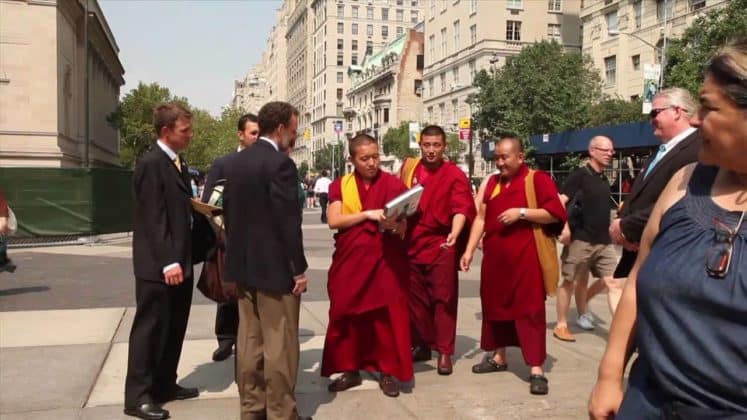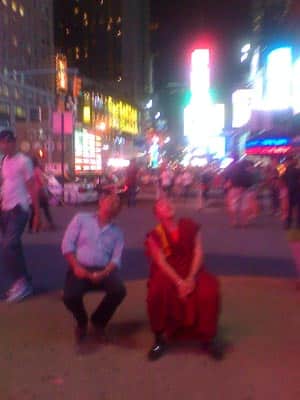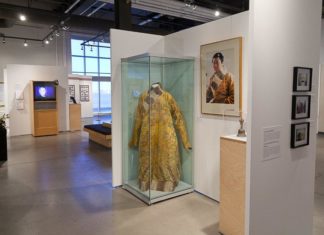by Barbara Elizabeth Stewart
Thursday evening, August 12
The Yangsi has left New York, left Vermont and is now alighting in Boulder. His New York visit was short but the Pema Tse Nyingtik—long-life—abhisheka, August 5, at Symphony Space was quite gorgeous. No wonder—it was the result of some six months of planning and meetings—staging, flowers, ritual items, concession items. Choreography, programs, ushers in satiny sashes: white or yellow, depending on their roles. It was organized by Mangala Shri Bhuti, Dzigar Kongtrul’s organization, with volunteers from all the centers. It’s not easy to stage a big visit without, at some point, irritating the volunteers more or less intensely—but honestly, Mangala Shri Bhuti did it. Partly, it was because they kept praising us and thanking us, so pleasant.
My job was helping Jean Thies, owner of Sharchen Imports, with the concession stand. There were four of us to set up and sell water bottles, rabbit pins, rabbit caps and rabbit umbrellas and hundreds rabbit t-shirts, including onesies.
Why the rabbit? Dilgo Khyentse Rinpoche’s name was Rabsel Dawa, Brilliant Moon. The Tibetans—along with the Japanese, Chinese and people throughout the East—see a rabbit in the moon. Apparently between the 8th and the 15th of each month—right now, actually —the rabbit’s ears are unmistakable except, apparently, to us in the West who see the man in the moon instead. There are, it seems, lots of fables, myths and parables involving the moon rabbit, including a koan-like teaching by the 11th century Indian mahasiddha, Padampa Sangye: “The rabbit that sees the moon is liberated from arrogance.” Enigmatic, to put it mildly. (And there is, as well, a brand new British gastropub, the Rabbit in the Moon, in Greenwich Village serving scallops and cod and steaks.)
The stage and shrine, topped by a huge White Manjushri, had a mosaic-like brillance. To the side was the case of relics—I am casting around for the word—boggling, mind-stopping. Encased in tiny glass stupas were: Marpa Lotsawa’s bone; Milarepa’s meditation belt; a yellowing page covered with King Trisong Detsen’s writing; and Mipham Rinpoche’s tooth and Chinese-looking bowl. There was Yeshe Tsogyal’s footprint in black rock and one of her hairs, a dark loop on white board. Clearly she was a small woman with small feet and coarse, wavy dark hair. Not hard to picture her now. And there were lively little figurines that had belonged to Dilgo Khyentse Rinpoche—a tiger cub, a Chinese man. (And more—some of Lord Buddha’s, it said, and Jigme Lingpa’s finger bone and Dilgo Khyentse Rinpoche’s prayer wheel…)
No question, relics and protection cords are two of the most fun parts of being Tibetan Buddhist.
The Yangsi came at 7, taking his seat up on the throne. He is 17, he looks 17 but his presence—relaxed and quietly confident—is clearly way beyond an ordinary 17 or an ordinary 60, for that matter. The house—750—was full. His voice was gentle, definite, but he didn’t say much. “You’re curious what I am going to say,” he said. “I’m glad. I’m just as curious about what you’re thinking.” Then he spoke of Dilgo Khyentse Rinpoche brilliance, his vast compassion and influence.
The Pema Tse Nyingtik empowerment, the program explained, is a mind terma by Dilgo Khyentse Rinpoche on a pilgrimage. He was doing a long-life feast offering by a white lake, when a square mandala with four gates and fully formed blue-green designs appeared before him and the Pema Tse Nyingtik arose fully formed in his mind.
The following year, on his way to visit his teacher, Jamyang Khyentse Chokyi Lodro, he dreamed that a juniper tree, which had sprouted from Guru Rinpoche’s staff, was growing by Crystal Lotus Cave, where he was spending the night. When he approached the juniper tree, a woman, Yeshe Tsogyal, handed him a white scroll—and the complete cycle of Pema Tse Nyingtik teachings manifested in his mind. Awake now, he wrote them down, and subsequently offered the empowerment to Chokyi Lodro, the Sixteenth Karmapa, the Dalai Lama, and others—including, now, we in New York, in Vermont, and soon, in Boulder and soon, Vancouver.
Up on stage, among others, including Jetsun Khandro Rinpoche, was Gesar Mukpo, representing Shambhala. The whole thing felt glittery and blessing-rich—the abhisheka, the blessing, the press of people with friends throughout. In the busy bustle after, the fast dismantling of the shrine, I sold the final t-shirts, packed up the caps and umbrella, and thought: I could do this every night, night after night, very happily. But this one night, receiving Khyentse Rinpoche’s terma—that’s lucky enough.
Wednesday evening, August 4
What a pleasant way to meet the Khyentse Yangsi—at a smallish gathering in the air-conditioned Shambhala Center, with platters of food and fancy pitches of ice tea and informal access to the Yangsi.
He arrived yesterday, disembarking at JFK to a contingent of 50 or 60 people, bowing, khatas extended. Then off in a car arranged by the Bhutanese mission, to the Waldorf-Astoria. They had been in India for the huge and apparently glorious 100th anniversary celebration of the birth of Dilgo Khyentse and in Bhutan for another huge, apparently splendid celebration of the same thing. They had been in Croatia and France and in Shechen monastery in Tibet, Rabjam Rinpoche told the sponsors today. In Tibet, they’d had two showers in 15 days. Now the Yangsi has landed in a luxury hotel with a marble bathroom and a steam bath. One extreme, he said, to the other.
The visit to New York, the Yangsi’s first time in the West, is short: three days, counting the arrival. Today was the sponsor’s tea, tomorrow is a sold-out long-life empowerment at Symphony Space on the Upper West Side.
The planning for this visit has been going on for months. Dzigar Kongtrul Rinpoche and the Mangala Shri Bhuti sangha are heading the whole visit ? New York, Vermont and Boulder— but the New York volunteers are from other groups, as well: Dzongsar Khyentse Rinpoche and Siddhartha’s Intent; Dzogchen Ponlop Rinpoche and Nalandabodhi and the Sakyong and Shambhala. We are Nyingmas and Kagyus, a gathering of cousins in the dharma. For months, there have been meetings and lists and plans—the procuring of brocades and cars and lumber for thrones and the coordination of schedules and the complicated logistics of an empowerment for some 750 people in a concert hall. The smallest things have engendered numerous emails and questions. Details, details—who buys the easel from Staples and who frames the photo of the Yangsi for the theater entrance hall? Who buys the rice and saffron and raisins for the welcoming offering at the Waldorf and who fixes it? Who writes and prints and sends out the invitations to the sponsor’s tea?
That one is easy—Vivian Kurtz, a longtime student of Dilgo Khyentse Rinpoche who has been running the Shechen organization in the West from time immemorial. The tea is for people who give a monthly donation to one of the 400 monks or students at Shechen in Nepal or the 75 nuns in the Shechen nunnery in Bhutan or to one of the three shedras for advanced education.
And there we were, dressed up nicely on a sweltering August afternoon in the city, plumped down on gomdens or metal chairs. When the Yangsi and Rabjam Rinpoche entered the shrine room, they walked briskly to the front, with the Yangsi settled comfortably onto the throne. He looks as young as he is—17. He spoke briefly, in a low and gentle voice. He seemed relaxed and he had a lovely, strong presence.
Then, we all moved into the adjacent shrine room, where a lavish tea was spread out. Hibiscus tea and tea sandwiches—green tea souffle on white with mayo and tiny grilled cheddar with truffles—and a cake with Shechen monastery magically projected on rice paper.
When my turn came, I knelt in front of him and said: I’m Barbara, a student of Trungpa Rinpoche and I sponsor Ani Karma in Paro, Bhutan. “Thank you,” he said, “thank you.”
But it is me who should be thanking Ani Karma, always. I met her at Dilgo Khyentse Rinpoche’s cremation in Paro in 1992—two weeks dripping with adhistana, in the homey exoticism of Bhutan. All of us—Bhutanese and monastics and Westerners—had gathered at the purkhang site the day after the cremation, for the conclusions of the ceremonies. Vivian, knowing I’d wanted to sponsor a Shechen monk, pulled me over and introduced me to Ani Karma—a nun with a strong, sweet face in her late 60’s. I spoke no Tibetan, she spoke no English, but I stood there beside her in front of the smoky cairn of the purkhang, weeping. Every year after I have sent her some money. In return she sends me Bhutanese table scarves and photos of herself and letters in Tibetan, translated by Shechen volunteers. Each year she writes that she has spent many months on retreat. Sometimes she says that she went on a pilgrimage to India. She tells me about her health. And she thanks me and promises to pray for me every day. I am so lucky—I have an accomplished yogini praying for me, regularly. I’ve never doubted that I am getting the better end of the deal by far.


















